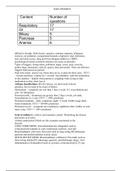Other
ATI-Med-Surg Exam Questions &Answers
- Course
- Nursing (ATIMEDICALSURG)
- Institution
- Thompson River University (TRU )
diffcult to breathe. Risk factors: genetics, immune response, allergens, exercise, air pollution, occupational hazards, respiratory tract infections, nose and sinus issues, drug and food allergens/additives, GERD, psychological factors (extreme emotion can cause an episode). Types of trigge...
[Show more]



